
Before I became interested in backpacking, I made several iterations of “bug out” bags. The idea of living out of a bag fascinated me; it was the ultimate freedom. My first bug out bag was an olive drab ALICE pack with three full MREs, an old poncho and liner, a cheap hunting knife that wouldn’t hold an edge, a ridiculous amount of cheap rope, some Potable Aqua tablets from Walmart, and a host of other items. It weighed something like 33 pounds, without water. I never took it on an overnight trip, and if I had, I probably would’ve been miserable.
After becoming interested in backpacking, it dawned on me that my bug-out bag and my back-packing kit filled a similar role: To survive outdoors and get from point A to point B. Since then, my views on bug out bags have changed somewhat.
I accepted the fact (begrudgingly) that the odds of racing into the woods at a moment’s notice to live like Sam in My Side of the Mountain were less likely than that of a family emergency, a tornado, or an ice storm. (Don’t worry, I still plan for that contingency, and I have an absolute blast doing it). If you don’t have a go bag, you should. It may make your life easier someday. Now, I use my backpacking kit for my “run off to the woods” bag. It’s much better than what I had all those years ago. It’s safer, more comfortable, and much lighter. I keep it packed and ready to go, so I never miss an adventure.
Ultralight Backpack
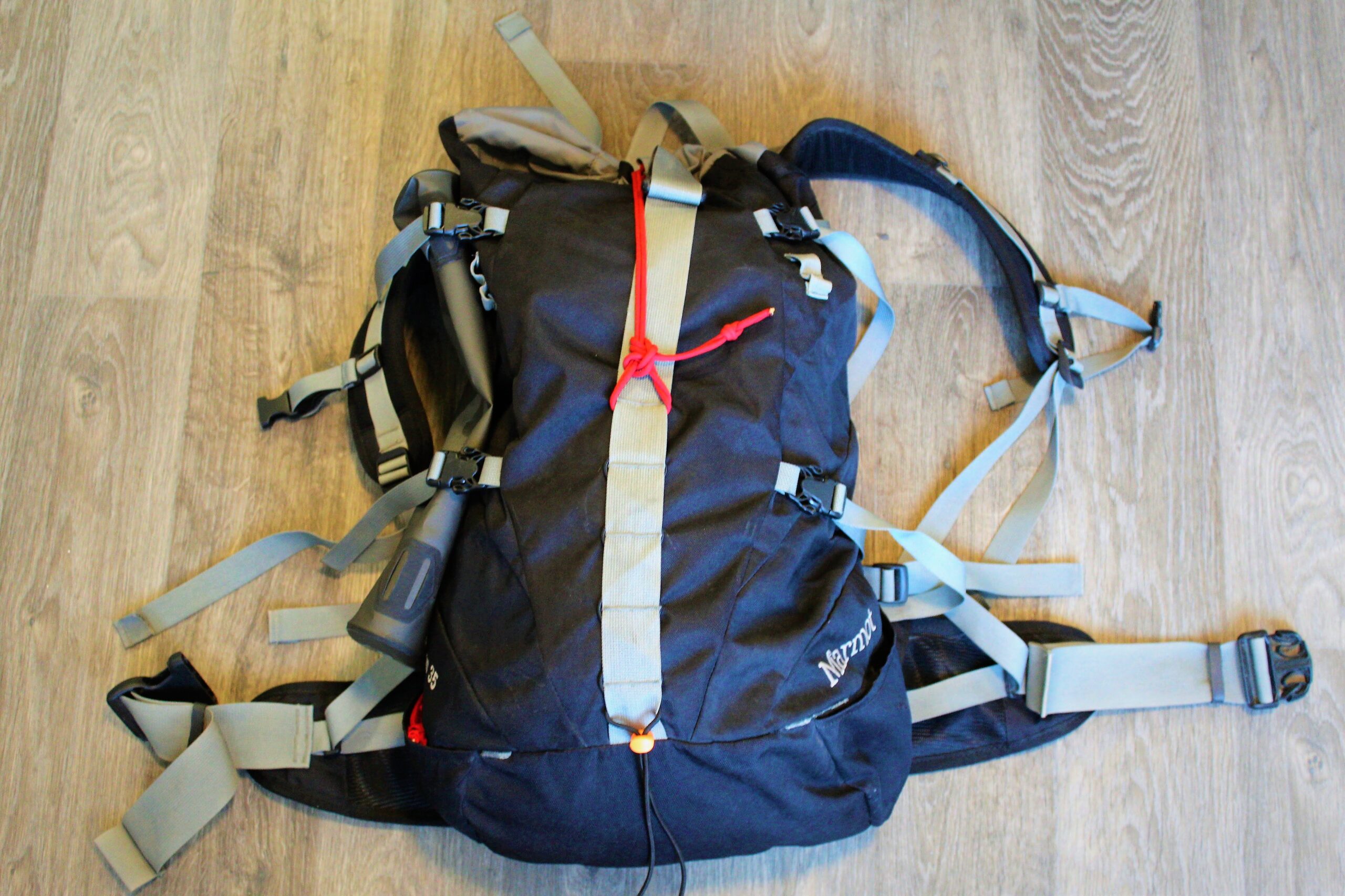
I wanted something simple, light, and durable. I’m not a big fan of tactical looking bags covered in molle (says the guy with two GoRucks). I didn’t need a huge pack, so I picked up a Marmot Aspen 35 from eBay. It had a hip belt, it wasn’t “tactical” looking, and the price was right. It had a lot of extra straps hanging off it I didn’t want, so I removed them, tossed the top flap, and pulled out the frame.
Lastly, I added some shock cord to the daisy chain stitched on the front for extra storage (a great place to let socks dry while on the move). I was left with a light and simple 35L pack that weighed about two pounds. The pack isn’t waterproof, and doesn’t have a pack cover, so I use a Sea to Summit dry bag to keep the contents safe. This has the added benefit of making the pack buoyant.
Last September I was getting my butt kicked in Buckskin Gulch, the longest slot canyon in the world. It was much wetter than we had anticipated. After heading north at the confluence with the Pariah River, we had to cross several muddy bodies of water. I stepped in one to cross, only to find the water was well over my head. Luckily, my pack floated and acted like a life preserver, and everything inside was kept dry.
Ultralight Sleep System
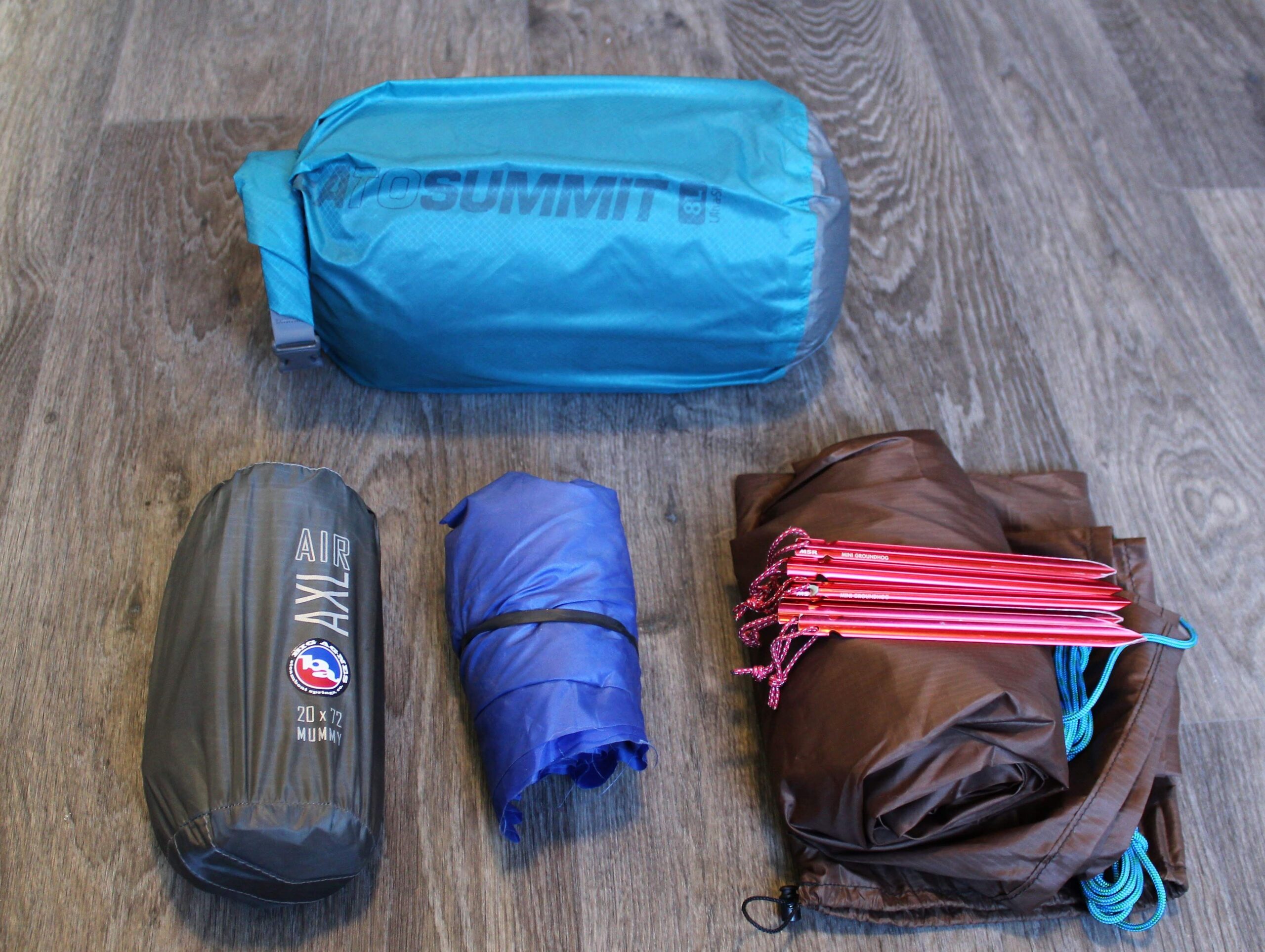
I began going on short overnight backpacking trips into the Spring Mountains. They’re like mini-bug out practice runs. This is an outstanding way to test your kit, and I urge you to try it if you have the means. I’m a light sleeper to begin with, so I had some adjusting to do.
I started with a Therm-A-Rest closed cell foam pad, which kept me warm but offered zero comfort from the hard ground I chose as a bed. Waking the next morning, my hips hurt in places I had never felt before. I love CCF pads because they don’t pop, but this just wasn’t going to do for me.
I upgraded to a Big Agnes AXL Air inflatable pad. I have my gripes, but its light and does the job. The CCF pad (and the rest of the “retired” gear) went to the get home kit I keep in the truck. A win-win! I bought a cheap “backpacker tarp” from Walmart and cut it down to about 3.5’ x 6.5’. I use this as a ground sheet.
For a blanket, I use a down throw from Costco. It cost around $20 and weighs one pound. In fact, it’s so light, I had trouble keeping it on at night. I folded the blanket in half and sewed the last few feet together to help secure it. I found this works well down to 50. I keep the down blanket in its own 8L dry bag to ensure it’s always good to go.
For a pillow, I just put clothes in an empty stuff sack. If coupled with a tarp shelter, I am comfortable in the 40s. I usually sleep in a stocking cap, to keep extra heat in. My old poncho liner went with my CCF pad to the truck kit. I don’t carry a tent. I have a Hennessy Hammock, but I only use that in warm weather when I’m sure there will be trees.
Most of the time I don’t carry a shelter. If I decide I need one, I use a custom sized Borah tarp. Tarp shelters can be configured many different ways and are lighter than tents. They may not keep the bugs out, but here in the southwest, that’s never been an issue for me.
Ultralight Cook System
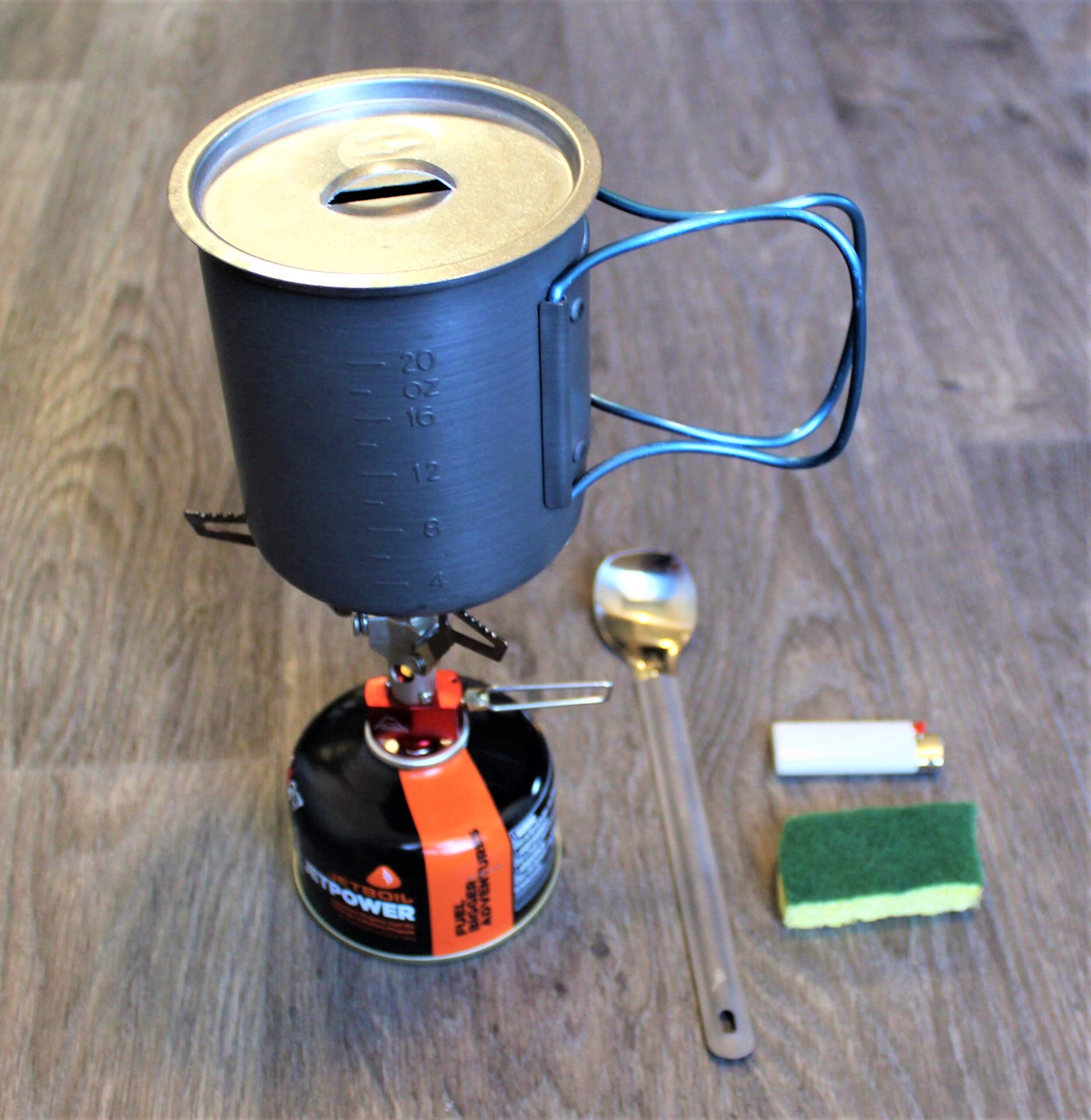
You can last weeks without food, but if you’re bugging out, you’ll need the calories. I keep two days of food packed and ready to go in my kit. For breakfast I have one cup of Mountain House blueberry oatmeal. A cliff bar is my lunch, and dinner is a two serving Mountain House meal.
Not the healthiest, but I can pack it and forget it. They are easy to prepare and delicious. If I have the forethought, I will pack some summer sausage, block cheese, and small tortillas. This makes a tasty and quick meal.
I was carrying a Jetboil Zip (which I love), but I wanted smaller and lighter. Off to the truck kit it went! I mainly needed a way to boil water for food, and as a backup for water purification. I didn’t want to splurge for a titanium cup, so I got an Aluminum Olicamp Space Saver Cup and MSR Pocket Rocket 2 .
The aluminum cup nests with a Nalgene, you can fit a small Jetboil gas canister in it, and it was way cheaper than titanium. I got a lid, and rubber banded it all together. Using a lid keeps heat in and boils water faster. I prefer only boiling water for meals, because it’s easier to clean, and the cup can fall right off the pocket rocket. I can add more water, but I would be seriously bummed if my food spilled. I keep a small butane lighter and a cut off piece of sponge with the cook kit. A long-handled titanium spoon is a must for eating out of a bag.
Water Purification and Storage
To purify water, I prefer tablets. They weigh next to nothing and don’t require pumping or squeezing. I haven’t had any issues with unpleasant taste. Just plop them in and wait. Most of the water sources around here are pretty clear. If you have murky water, you may need to strain it, or let the particles settle and pour off the good stuff. I have used a Sawyer Mini, and it works well for me. The only issue is its slow and requires a lot of squeezing (I use smart water bottles for this). I prefer carrying water in bladders, because it doesn’t slosh around. I use a three-liter Hydrapak bottle. I was using two Sawyer 64 oz bladders, but they both leaked.
First Aid
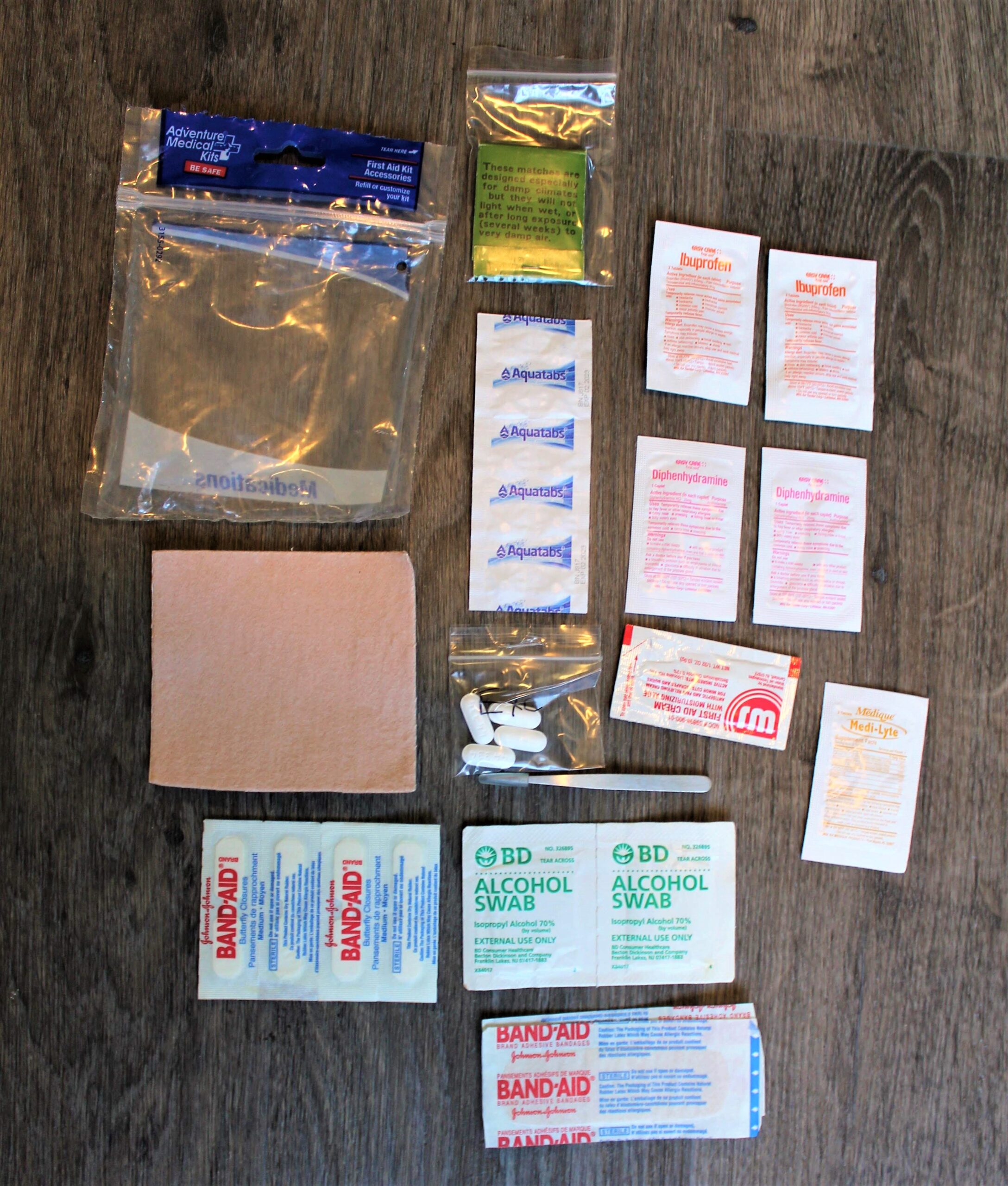
The first aid kit I carry is pretty sparse (it weighs just over an ounce). I have put a lot of effort into gathering knowledge in this area, so I can carry less. If things get hairy, I can toss in my trauma kit from my EDC. I carry ibuprofen, diphenhydramine (Benadryl), off brand Excedrin, electrolyte tablets, alcohol wipes, band aids, antibiotic ointment, sharp tweezers, moleskin, MRE matches, and extra water tablets. The tweezers are sharp enough to pop and blister, and the moleskin is great for treating them. The matches and extra water tablets weigh next to nothing and give me a little redundancy in important areas (two is one, one is none!).
Lightweight Toiletries
I keep this pretty light as well, I don’t need much. I carry a toothbrush, tooth paste, lip balm, and some wet wipes. I don’t carry deodorant. This weighs about 3 ounces.
Tools and Miscellaneous
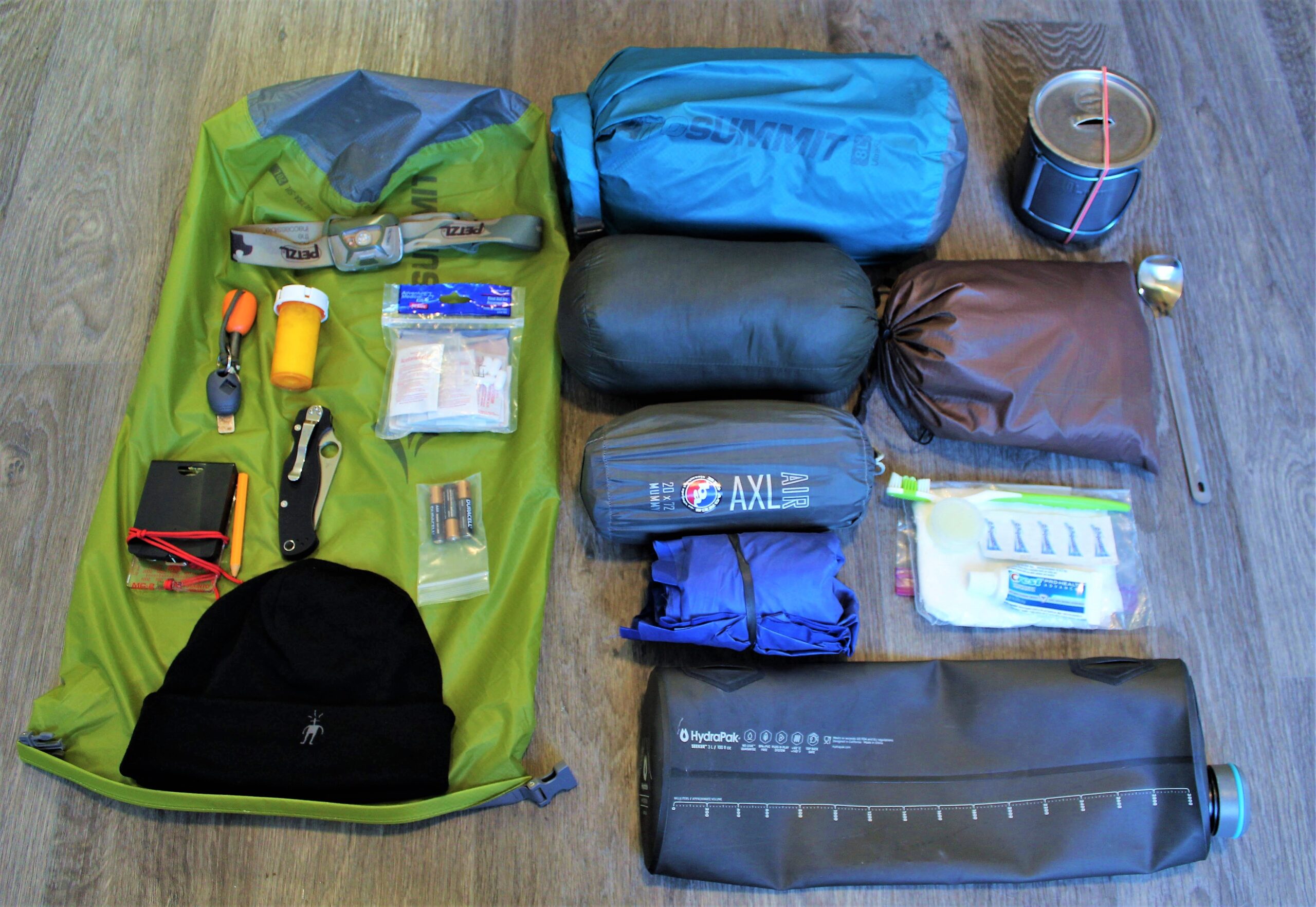
I carry a Suunto compass and pencil, a map of wherever I happen to be, headlamp and extra batteries, a Spyderco PM2, fire steel, cotton balls with Vaseline, and a spare bic lighter. Headlamps are great for keeping your hands free on the move. Cotton balls and Vaseline will burn for a couple minutes and catch a spark easily. Bic lighters weigh nothing. Carrying a couple lighters, matches, and a fire steel gives me a warm and fuzzy feeling. I like redundancy! I carry a wool beanie and a light packable down jacket.
I don’t usually carry rain gear or warmer clothes unless I know I need it. My SO usually carries a small trowel for digging cat holes and a small bottle of Dr. Bronner’s soap. These are good items to have.
Altogether, the base weight of this kit is a hair over 8 pounds (not counting consumables, these weights will vary). That’s super light, considering my piston LWRC (with Eotech, 30 round p-mag, white light, and sling) tips the scales at over 9 pounds. If you add on 3 L of water (1 Liter of water weighs 1 kilogram, or 2.2 pounds), the food, and gas, the kit’s weight doubles!
The weight is very important, it will be one of the main factors influencing how much ground you can cover, and how difficult it will be for you. Knowledge weighs nothing (except the crushing weight of student loan debt). The more you know and the more skills you have, the less you need to carry!
If needed, I have the extra room for more food, clothes, medical kit, and self-defense items. Best of all, I’m familiar with every piece of it and have used it on many overnight trips. Can you say the same for your bug out bag?

9 comments
A few items you should add is #1 a good knife or two, #2 a saw for wood processing, #3 cordage (550 or bank line), #4 heavy duty poncho because being wet and cold is miserable especially in a SHTF situation! I personally prefer tea candles to a canned fuel stove, they can be used for light (add more wick if you need more light, half a toothpick pushed in beside the wick does the trick), they’re lightweight, cheap, very common, add half a cotton ball and you get a decent flame, enough to boil water in a canteen cup stove. Impatient, add a second and/or third candle. I find that even a lightweight tent is worth the weight, as is a sleeping bag, you have to get good sleep, especially as you age! Yes, these will increase the load but they are better to have and not need then need and not have; I learned that thru experience. Just my twenty cents worth, hope it helped! GLAHP!
In addition to the recommendations for QUALITY 500 cord and a rope saw or folding mini saw, I would do more for medical situations. I recommend a minimum kit should include a tourniquet and QuikClot for medical emergencies.
I agree on the poncho; it can also replace the backpacking tarp. I would also replace the water tablets with iodine as this can be used for first aid. Also try Neosporin instead of Vaseline on your cotton balls which will also make them a first aid item. I refuse to carry anything that came serve at least two users, and prefer 3 or more.
I agree with the poncho instead of tarp. It gives you triple duty (rain gear/shelter/ground sheet) if you are trying to stay light. Alternatively just taking the tarp and one of those tiny fold up ponchos works well also. For my family I have a poncho in my kit, a tarp in my wife’s, and the one shot ponchos for her and the kids. This lets us make one cozy shelter or two separate ones if needed and still keep weight low. Though bugout bags for kids is a whoooole other article. I also have Iodine tabs for the dual use, but never considered Neosporin on the cotton balls. That’s a good idea, but Vaseline has first aid uses as well.
I almost always have a leatherman packed in my kit, but just a knife is probably sufficient. I’ve definitely seen many BoBs stocked with caffeine pills, and even packing a couple is a good idea for extra energy in a pinch or (and I can’t stress this enough) caffeine withdrawals for those with a heavy soda/coffee addiction. No sense wasting pain meds to combat the headaches when you can go 2 for 1 with a no-doz. Pack three and you have one a day for your 72 hours.
Packing a TQ would seem to be a necessity as well, either a separate one, or something like an Israeli bandage since it can dual duty for a pressure dressing or helping to immobilize a sprain. On that note I always like a shemagh or cravatte for a dust mask, (for storms, not real contaminants) cooling, head protection, first aid, etc.
You make a lot of good points. I make a habit of taking my get home bag whenever I day hike (once or twice a year). It only took one trip to convince me to cut 30 pounds down to 15. You save a lot of energy by reducing the load and because of that, your food and water will last longer. Each item should be evaluated based on whether it improves or hinders average mobility over 72 hours.
Does your arms fit in your backpack?
Thank you for this awesome blog! I do carry a backpack in my car! My backpacks change and evolve over time. I do work about 15miles from home and if a disaster happened I have what I need to get home to my family. Based on where I work If I had to walk home the journey would be longer, there are just some areas you want to stay out of all together. Time to go through it again and see just how much lighter I can make it. I have a pack for work and we have packs in the home too.
You can use dryer lint as a great firestarter too. Just keep a sandwich bag in your laundry room and every time you do a load of drying take the lint out of the dryer’s lint catcher and put it in the sandwich bag to take along in your bug-out bag.
I’d be out of line if I didn’t give credit for the dryer lint idea where it belongs, to ex-CIA Agent/operative Jason Hanson, who has been on Shark Tank and other TV programs.You can find him online easily if interested in more prepping ideas.